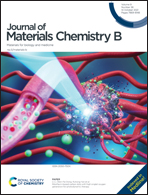Biodegradable polyurethane nerve guide conduits with different moduli influence axon regeneration in transected peripheral nerve injury†
Abstract
Nerve guide conduits (NGCs) can replace autogenous nerve grafting in the treatment of peripheral nerve system (PNS) injury. However, the modulus of polyurethane NGCs that affects the outcome of PNS repair has been rarely elucidated in vivo. In this study, we developed biodegradable waterborne polyurethane (BWPU) NGCs with an outer BWPU membrane and an inner three-dimensional scaffold structure. The mechanical properties of BWPU NGCs can be modified by adjusting the molar content of polyethylene glycol (PEG) in the soft segments within the BWPU. Two types of BWPU NGCs with different moduli were prepared, containing 17% and 25% PEG in BWPU (termed as BWPU 17 NGCs and BWPU 25 NGCs, respectively). In rat sciatic nerves with 10-mm transected injury, mechanically stronger BWPU 17 NGCs exhibited superior nerve repair, which was similar to that obtained by the current gold standard autograft implantation, whereas weaker BWPU 25 NGCs displayed an unsatisfactory effect. Histological results revealed that both BWPU NGCs had anti-inflammatory effects and altered the activation state of macrophages to M2 phenotypes to enhance PNS regeneration. The analysis of growth-associated protein 43 expression, which regulates axon growth, revealed that the mechanical properties of BWPU NGCs influence the outcome of PNS regeneration by affecting the formation and extension of axons. These findings suggest that the mechanical properties of NGCs could play a key role in regulating PNS repair and should be considered in future biomaterial NGC designs.



 Please wait while we load your content...
Please wait while we load your content...